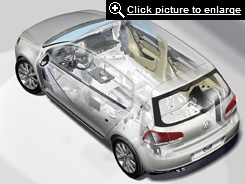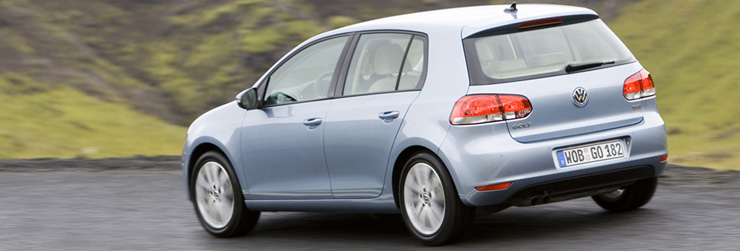Volkswagen Golf Mark 6 First Drive Review
20 Sep 2008|31,709 views
Well, we're a cynical bunch, and we're going to hold our horses until we test the new Golf along the cold, slippery roads of Iceland in about a week's time. The team headed up by the Group's chief designer, the Italian Walter de Silva, has gone in the way of giving the Golf a presence, sharpness, and power that they claim generates even more fun.
It's preliminary data also seems impressive - such as an average fuel consumption of 4.5 liters per 100 kilometers for a 110 PS TDI that we might get in light of the Polo BlueMotion. And upon request, the "park assist" will slot the Golf into a car lot in a busy carpark with minimal driver input. There's also the promise of distance control and "DCC Adaptive Chassis Control," the same technology used in the Audi A4's "drive select."
Democratizing progress
In Europe, the Golf will be offered as a two-door and four-door in the "Trendline", "Comfort-line" and "Highline" equipment levels. Fuel consumption has been claimed to be reduced by up to 28 percent, and all gasoline and diesel engines fulfill emission limits of the future Euro-5 standard.
In addition to DCC and distance control (ACC), a new ESP system incorporates finer response over its control range, with further optimized crash properties, seven airbags including knee airbag, the special head restraints (WOKS) that work to counteract whiplash trauma, a "seatbelt detection" feature debuting on the Golf in the rear seating area and daytime running lights - also standard equipment - provide for a maximum level of safety.
| |||||
 |
Exterior
While the side profile of the Golf 6's 5-door hatch leaves a fair reminder of the Golf 5, the rest of it quickly becomes evident on how much the Golf has changed and evolved, especially if you take a look at previous generations.
The design team - headed up by Walter de Silva, Klaus Bischoff and the Group's director for creative design, Flavio Manzoni - crystallized out the Golf's essential DNA, for example the first generation's front end and the C-pillar, and further refined it to be in-line with the rest of the Volkswagen family DNA.
The roof section is rather similar to the new Scirocco, and rests on a prominently contoured shoulder section. Responsible for this is a dominant curved line that extends from the headlights back to the taillights. Vee-dub calls this side profile a "character line" - it gives the Golf a fuller, lower stance on the road from a lateral perspective.
Beneath the matching bumper/radiator grille lines is a section with another air scoop. Also presented over a black background are the chrome light housings of the dynamically styled headlamps.
The rear too, is characterized by a predominance of horizontal lines. The taillights - now very wide - are marked among other things by a unique night design. Stylistically, the crystal-clear line of turn signal and backup lamps bears a resemblance to the taillights of the Touareg.
Overall, the new Golf - in the interplay of all of its design characteristics - gives the appearance of a significantly wider, flatter and sportier car that Volkswagen says is more upmarket.
Inside

The newly designed interior appears to have refined surfaces and features that are a pleasant visual departure from the Mark 5. Expect to see things like brushed chrome accents around the instruments, a steering wheel derived from the Passat CC, and a new RNS 310 radio-navigation system with touchscreen. The power window controls that are now located further forward in the door trim, making them easier to access.
New engine bearings, mirrors, special sound-damping film in the windshield and newly developed seal design on the doors and side windows claim to reduce road noise.
| |||||
 |
Engines and transmission
Volkswagen also claims for the new TDI engines to be exceptionally quiet. Of common rail technology, they are being implemented on the Golf for the first time.
Two balancer shafts (140 bhp variants) also eliminate undesirable vibrations. Plans call for a TDI power range from 90 bhp to 170 bhp. As always, every diesel is equipped with a diesel particulate filter (DPF).
Fuel efficiency for the 110 bhp variant is claimed to be just 4.5 l/100 km, with CO2 specific outputs of 119 g/km - a 0.6 liter reduction. The 140 bhp variant on the other hand does 4.9 liters of diesel, and 129 g/km of CO2, also 0.6 litres less than the previous generation.
As for petrol engines, the turbocharged/supercharged TSI range starts with an 80 bhp engine, and tops out at 160 bhp. The optimized 80 bhp entry-level engine consumes just 6.4 l/100km and outputs 149 g/km of CO2 - that's 0.5 liter less than its predecessor.
As expected, all gasoline and diesel engines will be mated to the DSG dual-clutch gearbox in either 6-speed or 7-speed configuration depending on engine torque. This effectively replaces the 6-speed automatic in the 2.0 FSI.
Just how good does it hold up to the Golf 5? Well, you'll have to wait and see till our road test of the Golf 6 in the coming weeks. Stay tuned!
Click on the following page for a detailed fact sheet of the Golf
| |||||
 |
The Volkswagen Golf 6 Facts Sheet
Automatic transmission: 6 and 7-speed DSG
Body: two and four doors with tailgate; key body sections are galvanized
Cargo area: 350 liter to 1,305 liter, 828 mm to 1,581 mm long
Character: bestseller, at home in all social classes
Chassis: MacPherson front suspension, multi-link rear suspension, ESP is standard, DCC Adaptive Chassis Control (optional)
Colors: "Candy white", "Black uni", "Tornado red", "Shark blue metallic", "Amaryllis red metallic", "Reflex silver metallic", "Shadow blue metallic", "Silverleaf metallic", "United grey metallic", "Blue graphite pearl effect", "Deep black pearl effect"
Design: Walter de Silva (Group), Klaus Bischoff (Brand), Flavio Manzoni (Creative Design), Marc Lichte (Model)
Dimensions: 4,199 mm long, 1,779 mm wide, 1,479 mm tall, tread width, front 1,540 mm; tread width, rear 1,513 mm
Drive: front wheel
Engine range: 59 kW / 80 PS to 125 kW / 170 PS; starting at 90 kW all gasoline engines are charged TSI engines; all diesels are new common rail TDI engines; all engines fulfill Euro-5 emissions standard
Engines - diesel: at launch with 81 kW / 110 PS (TDI), 103 kW / 140 PS (TDI); after time offset: 66 kW / 90 PS (TDI) and 125 kW / 170 PS (TDI)
Engines - gasoline: at launch with 59 kW / 80 PS, 75 kW / 102 PS, 90 kW / 122 PS (TSI), 118 kW / 160 PS (TSI)
Equipment lines: Trendline, Comfortline, Highline
Fuel consumption range: 4.5 liters to 7.1 liters per 100 kilometers
High-tech driving systems: DCC Adaptive Chassis Control, ACC Automatic Distance Control, Park Assist, Rear Assist rearview camera, Park Pilot with visual display
Infotainment: RDC 210, RDC 310, RDC 510 radio-CD player systems; RNS 310 (completely new) and RNS 510 radio-navigation systems; MEDIA-IN port, AUX-IN port, Excite Dynaudio sound system, hands-free unit
Market launch: starting in October 2008
Produced Golf cars, total: more than 26 million
Production sites: Zwickau and Wolfsburg
Standard equipment: includes ESP, seven airbags, air conditioning system, electro-mechanical power steering, power windows in front, multifunctional display, central locking, driver's seat height adjustable
Standard transmission: 5 and 6-speed manual transmission
| |||||
Well, we're a cynical bunch, and we're going to hold our horses until we test the new Golf along the cold, slippery roads of Iceland in about a week's time. The team headed up by the Group's chief designer, the Italian Walter de Silva, has gone in the way of giving the Golf a presence, sharpness, and power that they claim generates even more fun.
It's preliminary data also seems impressive - such as an average fuel consumption of 4.5 liters per 100 kilometers for a 110 PS TDI that we might get in light of the Polo BlueMotion. And upon request, the "park assist" will slot the Golf into a car lot in a busy carpark with minimal driver input. There's also the promise of distance control and "DCC Adaptive Chassis Control," the same technology used in the Audi A4's "drive select."
Democratizing progress
In Europe, the Golf will be offered as a two-door and four-door in the "Trendline", "Comfort-line" and "Highline" equipment levels. Fuel consumption has been claimed to be reduced by up to 28 percent, and all gasoline and diesel engines fulfill emission limits of the future Euro-5 standard.
In addition to DCC and distance control (ACC), a new ESP system incorporates finer response over its control range, with further optimized crash properties, seven airbags including knee airbag, the special head restraints (WOKS) that work to counteract whiplash trauma, a "seatbelt detection" feature debuting on the Golf in the rear seating area and daytime running lights - also standard equipment - provide for a maximum level of safety.
| |||||
 |
Exterior
While the side profile of the Golf 6's 5-door hatch leaves a fair reminder of the Golf 5, the rest of it quickly becomes evident on how much the Golf has changed and evolved, especially if you take a look at previous generations.
The design team - headed up by Walter de Silva, Klaus Bischoff and the Group's director for creative design, Flavio Manzoni - crystallized out the Golf's essential DNA, for example the first generation's front end and the C-pillar, and further refined it to be in-line with the rest of the Volkswagen family DNA.
The roof section is rather similar to the new Scirocco, and rests on a prominently contoured shoulder section. Responsible for this is a dominant curved line that extends from the headlights back to the taillights. Vee-dub calls this side profile a "character line" - it gives the Golf a fuller, lower stance on the road from a lateral perspective.
Beneath the matching bumper/radiator grille lines is a section with another air scoop. Also presented over a black background are the chrome light housings of the dynamically styled headlamps.
The rear too, is characterized by a predominance of horizontal lines. The taillights - now very wide - are marked among other things by a unique night design. Stylistically, the crystal-clear line of turn signal and backup lamps bears a resemblance to the taillights of the Touareg.
Overall, the new Golf - in the interplay of all of its design characteristics - gives the appearance of a significantly wider, flatter and sportier car that Volkswagen says is more upmarket.
Inside

The newly designed interior appears to have refined surfaces and features that are a pleasant visual departure from the Mark 5. Expect to see things like brushed chrome accents around the instruments, a steering wheel derived from the Passat CC, and a new RNS 310 radio-navigation system with touchscreen. The power window controls that are now located further forward in the door trim, making them easier to access.
New engine bearings, mirrors, special sound-damping film in the windshield and newly developed seal design on the doors and side windows claim to reduce road noise.
| |||||
 |
Engines and transmission
Volkswagen also claims for the new TDI engines to be exceptionally quiet. Of common rail technology, they are being implemented on the Golf for the first time.
Two balancer shafts (140 bhp variants) also eliminate undesirable vibrations. Plans call for a TDI power range from 90 bhp to 170 bhp. As always, every diesel is equipped with a diesel particulate filter (DPF).
Fuel efficiency for the 110 bhp variant is claimed to be just 4.5 l/100 km, with CO2 specific outputs of 119 g/km - a 0.6 liter reduction. The 140 bhp variant on the other hand does 4.9 liters of diesel, and 129 g/km of CO2, also 0.6 litres less than the previous generation.
As for petrol engines, the turbocharged/supercharged TSI range starts with an 80 bhp engine, and tops out at 160 bhp. The optimized 80 bhp entry-level engine consumes just 6.4 l/100km and outputs 149 g/km of CO2 - that's 0.5 liter less than its predecessor.
As expected, all gasoline and diesel engines will be mated to the DSG dual-clutch gearbox in either 6-speed or 7-speed configuration depending on engine torque. This effectively replaces the 6-speed automatic in the 2.0 FSI.
Just how good does it hold up to the Golf 5? Well, you'll have to wait and see till our road test of the Golf 6 in the coming weeks. Stay tuned!
Click on the following page for a detailed fact sheet of the Golf
| |||||
 |
The Volkswagen Golf 6 Facts Sheet
Automatic transmission: 6 and 7-speed DSG
Body: two and four doors with tailgate; key body sections are galvanized
Cargo area: 350 liter to 1,305 liter, 828 mm to 1,581 mm long
Character: bestseller, at home in all social classes
Chassis: MacPherson front suspension, multi-link rear suspension, ESP is standard, DCC Adaptive Chassis Control (optional)
Colors: "Candy white", "Black uni", "Tornado red", "Shark blue metallic", "Amaryllis red metallic", "Reflex silver metallic", "Shadow blue metallic", "Silverleaf metallic", "United grey metallic", "Blue graphite pearl effect", "Deep black pearl effect"
Design: Walter de Silva (Group), Klaus Bischoff (Brand), Flavio Manzoni (Creative Design), Marc Lichte (Model)
Dimensions: 4,199 mm long, 1,779 mm wide, 1,479 mm tall, tread width, front 1,540 mm; tread width, rear 1,513 mm
Drive: front wheel
Engine range: 59 kW / 80 PS to 125 kW / 170 PS; starting at 90 kW all gasoline engines are charged TSI engines; all diesels are new common rail TDI engines; all engines fulfill Euro-5 emissions standard
Engines - diesel: at launch with 81 kW / 110 PS (TDI), 103 kW / 140 PS (TDI); after time offset: 66 kW / 90 PS (TDI) and 125 kW / 170 PS (TDI)
Engines - gasoline: at launch with 59 kW / 80 PS, 75 kW / 102 PS, 90 kW / 122 PS (TSI), 118 kW / 160 PS (TSI)
Equipment lines: Trendline, Comfortline, Highline
Fuel consumption range: 4.5 liters to 7.1 liters per 100 kilometers
High-tech driving systems: DCC Adaptive Chassis Control, ACC Automatic Distance Control, Park Assist, Rear Assist rearview camera, Park Pilot with visual display
Infotainment: RDC 210, RDC 310, RDC 510 radio-CD player systems; RNS 310 (completely new) and RNS 510 radio-navigation systems; MEDIA-IN port, AUX-IN port, Excite Dynaudio sound system, hands-free unit
Market launch: starting in October 2008
Produced Golf cars, total: more than 26 million
Production sites: Zwickau and Wolfsburg
Standard equipment: includes ESP, seven airbags, air conditioning system, electro-mechanical power steering, power windows in front, multifunctional display, central locking, driver's seat height adjustable
Standard transmission: 5 and 6-speed manual transmission
| |||||
Thank You For Your Subscription.




























